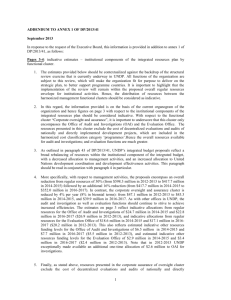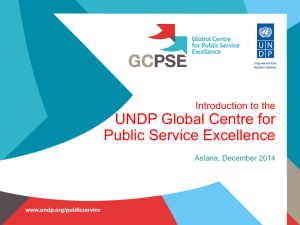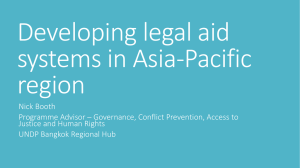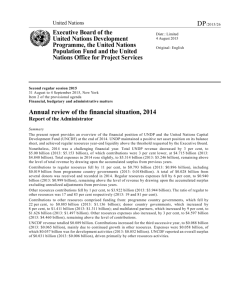Summary tables
advertisement
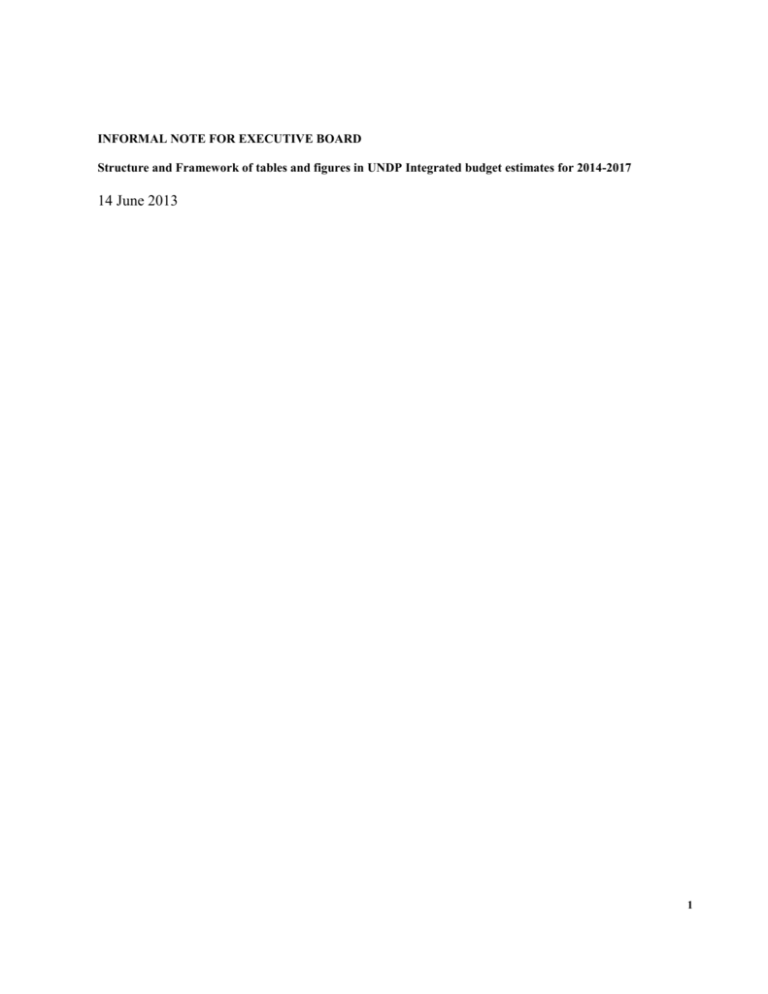
INFORMAL NOTE FOR EXECUTIVE BOARD Structure and Framework of tables and figures in UNDP Integrated budget estimates for 2014-2017 14 June 2013 1 DP/2013/41 Contents I. Strategic context .................................................................................................................................. II. Financial context…………………………………………………………………………………. III. Programmatic components of the integrated budget .......................................................................... IV. Institutional components of the integrated budget Terminology and definitions Organizational chart Tables 1. Integrated resources plan ................................................................................................................................ 2. Proposed annualized programming financial framework ............................................................................... 3. Comparison of institutional components of integrated budget 4. Summary of main areas of increase/decrease – institutional component ........................................................ 5. Government contributions to local office costs income by category of countries .......................................... 6. Government contributions to local office costs waivers by gross national income level ................................ 7. Regular resources funded senior posts by location 8. GMS cost recovery income and utilization Figures 1. Contributions by funding category ................................................................................................................... 2. Estimated use of total resources Summary tables 1. Comparison of 2012-2013 resources plan with actuals/estimates .................................................................... 2. Integrated resources plan - estimates covering 2014-2017…………………………………… Annexes 1. Results and resources framework .................................................................................................................. 2 Organizational Chart 3 I. Strategic Context 1. The present document is an integral complement to the strategic plan, 2014-2017. The integrated results and resources framework in the Strategic Plan forms the foundation of UNDP’s integrated budget and sets out the framework for the estimates and proposals included herein, covering both regular and other resources for 2014-2017. The strategic plan articulates strategic priorities and results areas, as well as the linkage of resources to results through the integrated results and resources framework across all harmonized cost classification categories – development activities (including programme and development effectiveness activities), UN development coordination activities, management activities, and special purpose activities. The present document provides more information on the resources estimates in the integrated results and resources framework. 2. The presentation follows a budget harmonization exercise within the context of a “road map to an integrated budget from 2014 onwards” conducted with UNICEF, UNFPA and UNWOMEN covering a harmonized cost classification framework (decision 2010/32), a harmonized conceptual cost recovery methodology and harmonized cost recovery rates (decisions 2012/27 and 2013/9). It also fully incorporates the harmonized results-based budgeting approach approved in decision 2011/10, including: (i) improved results focus and linkage with the strategic plan; and (ii) harmonized budget tables with respect to the integrated resource plan (table1); a comparison of planned and actual/estimated expenditures (summary table 1); and an integrated results and resources framework (annex 1) aligned with the strategic plan. 3. For the first time, Executive Board decision will be sought within the framework of a single integrated presentation, on all regular resources funded budget items - areas previously legislated through two distinct funding instruments – the institutional budget and the programming arrangements. This holistic approach acknowledges the synergies and linkages between development and institutional at country, regional and global levels, and the associated resource requirements. It recognizes that institutional activities represent essential strategic enablers for the achievement of development results. This will in turn better facilitate the process of continuous re-alignment of institutional capacities required to help programme countries achieve development results within the remit of the strategic plan. II. Financial context 4. This paper is premised on UNDP’s financial regulations and rules and relevant executive board decisions. This chapter focuses on the overall financial context, whereas chapters III and IV discuss programmatic and institutional components, respectively. 5. Figure 1 provides an overview of actual and estimated contributions, by funding category, spanning the past and future strategic planning periods (2008-2013 through 2014-2017). 4 Figure 1. Contributions by funding category, 2008-2009 to 2016-2017 in millions of US dollars 7,000 6,253 6,025 6,630 6,000 6,506 5,467 5,000 4,000 3,000 2,112 1,942 2,000 1,812 1,756 1,550 1,850 1,750 1,500 1,500 1,500 1,000 0 2008-2009 2010-2011 2012-2013 (est) 2014-2015 (est) 2016-2017 (est) Other resources - bilateral and multilateral partners resources Regular resources Other resources - government cost-sharing 6. Figure 2 provides an overview of the proposed use of total gross projected resources for 2014-2015 – estimated at $11.1 billion – of which 88.7 per cent will be used for development activities, 1.7 per cent for United Nations development coordination activities, 8.2 per cent for management activities, and 1.4 per cent for special purpose activities. Planned development expenditures for 2014-2015 of 88.7 per cent of total planned resources utilization compares favourably to the 88.0 per cent currently estimated for use during 2012-2013. Similarly, planned management expenditures for 2014-2015 of 8.2 per cent of total planned resources utilization compares favourably to the 8.6 per cent currently estimated for use during 2012-2013 Figure 2. Estimated use of total resources: 2012-2013 compared to 2014-2015 in millions of US dollars 2012-2013 2.2% 2014-2015 8.6% 1.7% 1.2% 8.2% 1.5% 88.7% 88.0% $9.5 billion $9.8 billion Total: $10.8 billion Total: $11.1 billion 88.0% 8.6% Development activities 2.2% UN development coordination Management activities Special purpose activities 1.2% 5 DP/2013/41 7. The integrated resources plan, presented in Table 1, covers both regular and other resources. It outlines the integrated resources framework of UNDP, and reflects cost classification categories approved in decision 2010/32. In addition, it contains a separate column related to cost recovery in line with the harmonized format for the integrated resources plan. The integrated resources plan reflecting estimates for the period 20142017 is presented in summary table 2 and forms the basis for delivery of the results contained in the new Strategic Plan 2014-2017 8. The Strategic Plan 2014-2017 provides the single overarching strategic framework for UNDP’s activities and as such contains the results and resources framework, which is turn is directly linked to the Integrated Budget 2014-2017. The detail of this linkage will be explained in Annex 1 to this document. 9. Regular resources available for programmatic components of the integrated resources plan are discussed in chapter III. Proposals and cost implications of the institutional components of the integrated resources plan within the integrated budget are presented in chapter IV. 6 Table 1. Integrated resources plan in millions of US dollars 2012 (actuals) + 2013 (estimates) Regular resources Regular resources 2014-2015 budget estimates Other resources Regular (other income utilization) resources a/ Bilateral + multilateral partners resources Government cost-sharing Regular resources Cost recovery Regular resources Total resources Other resources Regular (other income utilization) resources a/ Bilateral + multilateral partners resources Government cost-sharing Cost recovery Total resources 1. Resources available - Opening balance b/ - Income and adjustments Contributions Other, including reimbursements for services to other UN organizations, and cost recovery c/ - - Total 1. Resources available - - - - - - 2. Use of resources - - - - - % of Total % of Total I. Development activities - I.A - Programme - I.B - Development effectiveness Total - I. Development activities - - - - - - Total - II. UN Development Coordination activities - - - - III. Management activities III.A - recurring - III.B - non-recurring - Total - III. Management activities - - - - IV. Special purpose activities IV.A - Capital investments - IV.B - Non-UNDP operations administered by UNDP - Total - IV. Special Purpose activities - - - - Total institutional component - Total programming component Total 2. Use of Resources (I + II + III + IV) - - 3. Balance of resources - - - - - a/ Includes government contributions towards local office costs (GLOC), income the United Nations Volunteers programme derives from providing volunteers to the United Nations organizations, and an accounting linkage to off-set the costs of reimbursing income taxes paid by United Nations staff on their salaries. b/ Opening balance for 2012/2013 reflects actual amount recorded in the UNDP 2012-2011 Financial Statements. Following the harmonized format for the integrated budget presentation, cost recovery opening balances are co-mingled with bilateral/multilateral and local resources opening balances accordingly. c/ Includes interest, miscellaneous income and adjustments related to foreign exchange gain/loss, opening reserve increases/ decreases, and miscellaneous expenditures. Summary institutional component: I.C - Development effectiveness II.B - UN development coordination III.A - Management recurring III.B - Management non-recurring IV. - Special purpose activities Total: - - - - 2012-2013 2014-2015 7 - - III. Programmatic components of the integrated budget 10. Table 2 below will show the proposed allocation of regular resources to programmatic activities at $540 million and $600 million annual levels. Table 2. Proposed annualized programming financial framework covering 2014-2017 in millions of US dollars I - Development Activities Programmes 2014-2015 2016-2017 at $540m base per year at $600m base per year Country window TRAC-1 TRAC-2 TRAC-3 Programme of Assistance to the Palestinian People (PAPP) Subtotal Country window - Regional window Regional Programme Global window Global programmes (includes ODS) Human Development Report Office (HDRO) Subtotal Global Window - Subtotal - Programmes II - Development Effectiveness South-South cooperation programme Development support services (DSS) Economists' programme Gender mainstreaming Policy advisory services United Nations Capital Development Fund Subtotal - Development Effectiveness - Subtotal - Development II - UN Development Coordination Support to the RC Grand total (I + II) IV. Institutional components of the integrated budget Table 3. Comparison of the institutional components of the integrated budget, 2012-2013 approved, 2014-2015 estimates and 2016-2017 notional estimates in millions of US dollars Summary institutional components: I.C - Development effectiveness II.B - UN development coordination III.A - Management recurring III.B - Management non-recurring IV. - Special purpose activities Total: 2012-2013 approved budget 2014-2015 budget estimates 2016-2017 notional estimates 8 Table 4. Summary of main areas of increase/decrease- institutional component of the integrated budget in millions of US dollars Total: I. 2012-2013 net approved institutional budget appropriations II. Cost increases (non-discretionary) % of 2012-2013 approved gross appropriation Estimated inflation on staff entitlements and operating costs Estimated increase of United Nations common system salary scale revisions Estimated impact of currency adjustments Total cost increases III. a. Exercising budgetary discipline (volume decreases) Alignment with projected voluntary contribution levels Net changes due to implementation of decision 2013/9 on cost recovery Reductions due to completion of one-time investments Total volume decreases b. Investing in the organization (volume increases) Management activities - non-recurring Implementing the change agenda Total volume increases Net volume decreases (III.a + III.b) IV. Net institutional budget reductions (II + III) V. 2014-2015 net appropriation estimates (I + IV) VI. Estimated income to the institutional budget VII. 2014-2015 gross appropriation estimates (V. + VI.) A. Cost increases 11. The estimated cost increases and decreases proposed in table 4 are described in this section. B. Volume changes 12. The volume reductions in the institutional component of the integrated budget are described in this section. C. Estimated income to the budget 13. The total estimated income to the institutional component of the integrated budget is described in this section. D. Government contributions towards local office costs (GLOC) 14. Table 5 shows 2012 GLOC from direct cash payments, accounting linkage with voluntary contributions, and in-kind contributions broken down by the income category of programme countries and described in details in this section. Table 6 presents GLOC waiver percentages. 9 DP/2013/41 Table 5. Government contributions to local office costs income by category of countries, 2012 (in millions of US dollars) GLOC obligations, including inkind contributions Income category Income received Cash and accounting linkage In-kind contributions Total income received Percentage received against obligation Low-income countries Middle-income countries Net contributor countries Total Table 6. Government contributions to local office costs waivers based on 2008-2011 average GNI per capita Programme Country Waiver Percentage Based on 2008-2011 average GNI per capita (in US dollars) Income category of programme country Table 7 – Regular resources senior posts, by location Change (increase/ decrease/ reclassifications 2012-2013 approved posts ADM, USG, ASG D2 D1 Total ADM, USG, ASG D2 D1 Total 2014-2015 proposed posts ADM, USG, ASG D2 D1 Total 1. Management Country and regional offices Headquarters Subtotal: 2. Development effectiveness Country and regional offices Headquarters Subtotal: 3. UN development coordination Country and regional offices Headquarters Subtotal: 4. Special purpose Country and regional offices Headquarters Subtotal: Grand Total: 15. Table 7 above presents regular resources funded senior positions by location. 16. Table 8 below presents cost recovery income and utilization related to cost recovery on bilateral and multilateral resources, cost recovery on local resources and other cost recovery related resources, in a harmonized format with UNICEF, UNFPA and UNWOMEN. 10 Table 8 – Cost recovery income and utilization, in millions of US dollars 2012 (actuals) + 2013 (estimates) GMS - cost recovery on bilateral/ multilateral partners resources GMS - cost recovery on government cost-sharing Other recovery related resources 2014-2015 budget estimates Total resources GMS - cost recovery on bilateral/ multilateral partners resources GMS - cost recovery on government cost-sharing - - Other recovery related resources Total resources 1. Resources available Income, including reimbursements for services to other UN organizations, and cost recovery c/ - - - 2. Use of resources I. Development activities I.A - Programmes 1.B - Development effectiveness - - - - - - - - Total - I. Development activities - - - - - - - - Total - II. UN Development Coordination activities - - - - - - - - III. Management activities III.A - recurring III.B - non-recurring Total - III. Management activities - - - - - - - - - - - IV. Special purpose activities IV.A - Capital investments IV.B - Non-UNDP operations administered by UNDP Total - IV. Special Purpose activities - - - - - - - - - - - - - - - - II. UN Development Coordination activities Total 2. Use of Resources (I + II + III + IV) G. United Nations Development Coordination activities 17. A discussion is included on UNDP’s continued strong support for stewardship of UN coordination activities. H. Special purpose activities 18. Special purpose activities, including non-UNDP operations administered by UNDP and capital investments, are proposed to be $xx million for the 2014-2017 period, comprised of $xx million in regular resources, plus $xx million in other resources. NonUNDP operations administered by UNDP include UN Volunteers (UNV) and UN Capital Development Fund (UNCDF). 11 Summary table 1 –Comparison of 2012-2013 resources plan with actuals/estimates in millions of US dollars 12 Summary table 2 – Integrated resources plan – estimates covering 2014-2017 in millions of US dollars 13 DP/2013/41 Annex 1 – linkage of resources to results (From draft strategic plan DP/2013/12, Annex 2) 14





